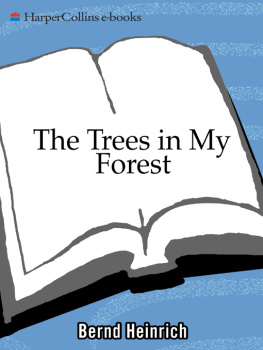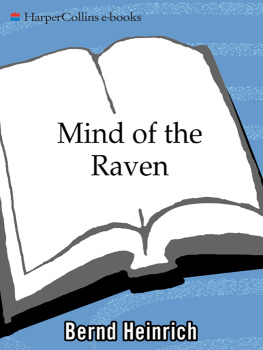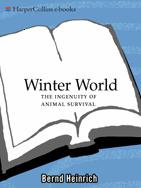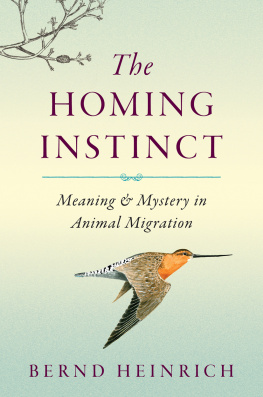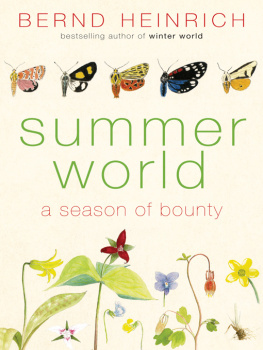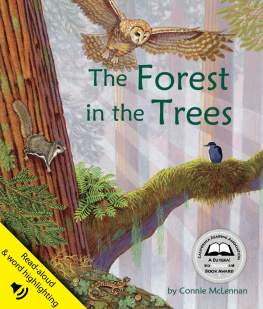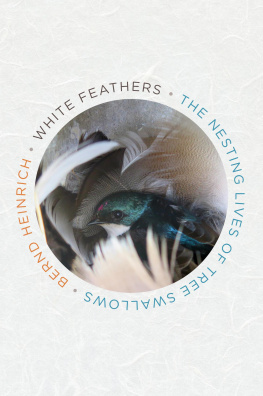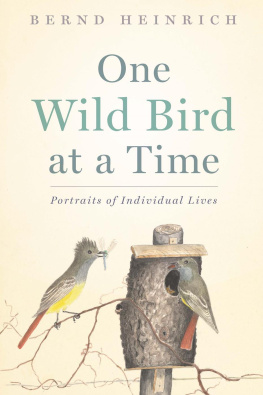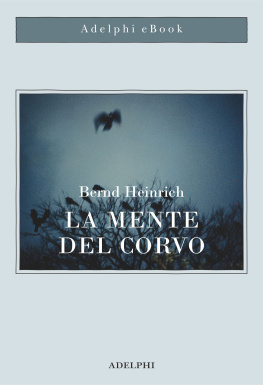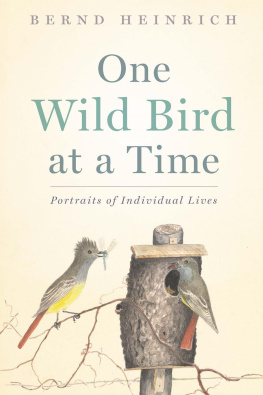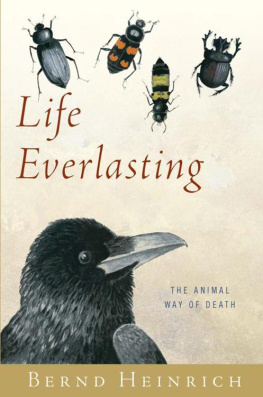Bernd Heinrich - The Trees in My Forest
Here you can read online Bernd Heinrich - The Trees in My Forest full text of the book (entire story) in english for free. Download pdf and epub, get meaning, cover and reviews about this ebook. year: 1998, publisher: Harper Perennial, genre: Detective and thriller. Description of the work, (preface) as well as reviews are available. Best literature library LitArk.com created for fans of good reading and offers a wide selection of genres:
Romance novel
Science fiction
Adventure
Detective
Science
History
Home and family
Prose
Art
Politics
Computer
Non-fiction
Religion
Business
Children
Humor
Choose a favorite category and find really read worthwhile books. Enjoy immersion in the world of imagination, feel the emotions of the characters or learn something new for yourself, make an fascinating discovery.
- Book:The Trees in My Forest
- Author:
- Publisher:Harper Perennial
- Genre:
- Year:1998
- Rating:5 / 5
- Favourites:Add to favourites
- Your mark:
- 100
- 1
- 2
- 3
- 4
- 5
The Trees in My Forest: summary, description and annotation
We offer to read an annotation, description, summary or preface (depends on what the author of the book "The Trees in My Forest" wrote himself). If you haven't found the necessary information about the book — write in the comments, we will try to find it.
New England Book Award Best
Nonfiction Award
and the Franklin Fairbanks
Award of the Fairbanks Museum
In a book destined to become a classic, biologist and acclaimed nature writer Bernd Heinrich takes readers on an eye-opening journey through the hidden life of a forest.
The Trees in My Forest — read online for free the complete book (whole text) full work
Below is the text of the book, divided by pages. System saving the place of the last page read, allows you to conveniently read the book "The Trees in My Forest" online for free, without having to search again every time where you left off. Put a bookmark, and you can go to the page where you finished reading at any time.
Font size:
Interval:
Bookmark:



We travel the milky together, trees and men
John Muir
This book would probably not have been written if it were not for my Winter Ecology students. Every year, they help me see new things and infect me with new enthusiasm for these woods. I have also walked in the woods with foresters and tried to see the woods through their eyes, always with great pleasure. They are Malcolm Mac McClean, Steve Gettle, Steve Pottle, Bob Lesso, Edward Witt, and Cy Balch. I profited greatly from discussions, editorial comments, and valuable suggestions by Bill Alverson, Virginia Barlow, Diane Reverand, John Perry, Rebecca Lowen, and Glenn Booma. Above all I thank my wife, Rachel Smolker, for being a companion, a helper, and a critical editor when I needed one the most.
Having been partly arboreal since the age of eight, I learned early on that trees contain birds nests, safety, grand vistas, and apples. Climbing tall trees gave me a soaring feeling of achievement. Under the cover of a canopy of green leaves I could peer down, knowing I was safe from the wild boars and other beasts I imagined marauding on the ground. Trees were the best toys for hanging, swinging, daring, and showing off.
For a while I lived on a farm with the family of Floyd and Leona Adams and their three boys, Jimmy, Butchy, and Billy, who were near my age, about ten. At the farm, I was mainly interested in looking for birds nests, fishing, raising butterflies and moths from caterpillars, and, on occasional nights, chasing after raccoons with the baying hound down in the swamp by Pease Pond. There were rare and secretive birds here and even rarer and more mysterious insects. All lived in the trees in the surrounding forest that seemed to go on forever. The forest was a given, like the air we breathed and the waters of the streams and lakes we swam and fished in. My parents bought a rundown farm with seventy acres of forest just across the hollow from the Adams family, past a forest-bordered pond. In the summer, I ran across the fields and through the shaded hemlock woods between the Adamses place and ours.
There were heavy snows that first winter, which was also the winter that my parents decided theyd rather work in the woods than in the mill. My father borrowed a crosscut saw from our neighbors Phil and Myrtle Potter. Every dawn, he and my mother, a petite redheaded woman barely five feet tall, trudged through the deep snow into our woods to saw logs for the nearby Rumford paper mill. Everyone else was using chain saws by then. We could not afford one, nor would my father deem it necessary to use one, inasmuch as he determined that the crosscut saw did cut logs, given sufficient honest effort. I remember watching them once saw down a large ash tree that, when it fell, crashed out of sight in the snow. They had to dig trenches around it to saw it into the four-foot sections required for paper pulp wood. These they rolled onto a borrowed toboggan, one by one, and pulled them to stack into a neat pile along a path. From there theyd haul the wood out to the main road by sledge pulled by Susie, a light brown horse that belonged to another neighbor, Harold Adams. Meanwhile, I climbed a nearby sugar maple, jumped off, and instantly became buried up to my neck in the heavy, damp snow. My parents had to dig me out, too.
Some years later, I planted a row of trees down our long driveway to the farmstead. I alternated sugar maples, red maples, white ash, red oak, and basswoods. The basswoods hum in June with the thousands of bees that visit their blossoms. The red oaks feed squirrels and blue jays. The white ash seeds sometimes feed flocks of pine grosbeaks, who come from the far north in the winter. The maples give syrup in March, a beautiful display of yellow flowers in May, and spectacular golden and red foliage in October.
We already had other trees around the house. There were two massive elm trees by the barn. One of them was chosen each spring by the bright orange and black northern orioles to suspend their baglike nest, woven out of gray weathered milkweed fibers, onto an inaccessible tip of a long drooping branch. The sugar maples around the house had been planted at least a hundred years before. Some of their thick limbs had broken off, leaving suitable sites where hairy and downy woodpeckers excavated their nest holes. These holes later became nesting cavities for eastern bluebirds and tree swallows. One large cavity from a rotten tree limb was for many years used by a pair of kestrels that hunted mice and grasshoppers in our meadow. These trees were a link to life. Seeing them connected to the birds lives, I felt somehow connected to them as well.
Life has been likened to a tree of many branches. We and spruce trees are two separate twigs of two major branches. By this analogy, the seedling of which the tree of life originated was a bacteria-like microorganism that flourished in the seas and became the ancestor of all life on earth. Our ancestry is still evident in the sequence of bases that make up the genetic code in DNA. The more ancient the divergence from the common ancestor, the greater the change in the sequence of these bases. The amount of molecular change can therefore be used like a clock. We calibrate this molecular clock with known events as seen from the fossil record in dated rocks. According to this molecular clock, life originated about four billion years ago. Plants, animals, and fungi diverged from a common ancestor about one billion years ago. We are all highly evolved organisms, each in our separate ways.
Trees appear vastly different from us, but at the cellular and biochemical levels, they are remarkably similar. Like us, their genetic code is indicated by the same triplets of bases that signify the same amino acids in protein chains. They use the same molecular mechanisms for translating the triplets into proteins. Our biochemical pathways for synthesis and energy conversion are similar. In trees as in humans, genetic information in DNA is packaged in chromosomes in a nucleus and the same mechanisms translate that information into growth through hormones. Despite the vast potential alternatives, we find that the closer we look at the organisms of this earth, the more similar (though individually distinct) we are. It is due to common ancestry.
When we take a broader view, we see similarities as well. (But these are probably less arbitrary and more due to convergence.) Trees take in nutrients and respond to their environment. They grow, have sex, reproduce, and senesce. They have predators and protect themselves against them. They succumb to viral, fungal, and bacterial diseases, but they also have defenses. They contend with intense competition from their own kind and others. Although rooted in place, they move, respond to stimuli, and have elaborate mechanisms of dispersing and invading new territory.
Trees are more than distant relatives. They are and have been our intimate associates throughout the whole of our evolutionary history. Our primate ancestors lived in the trees. Millions of years later their descendants built civilizations with trees. The forest provided and still provides us with many raw materials for life, from food to tools, fuel, weapons, clothing, and building materials. Forests ecologically maintain our atmosphere, protect us from flood and erosion, and moderate climate.
Font size:
Interval:
Bookmark:
Similar books «The Trees in My Forest»
Look at similar books to The Trees in My Forest. We have selected literature similar in name and meaning in the hope of providing readers with more options to find new, interesting, not yet read works.
Discussion, reviews of the book The Trees in My Forest and just readers' own opinions. Leave your comments, write what you think about the work, its meaning or the main characters. Specify what exactly you liked and what you didn't like, and why you think so.

